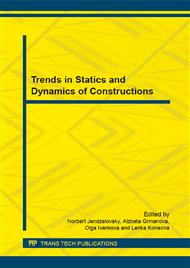p.3
p.9
p.13
p.19
p.25
p.29
p.36
p.43
Problems Connected with the Application of Lamella Flanges in Steel Bridge Construction
Abstract:
Lamella flanges (Fig. 1) have lately grown popular with the designers of steel bridges –in their belief that these flanges provide us with the possibility of avoiding very thick flange plates in steel bridge structures. This belief is based on the assumption that the lamellas are perfectly plane and, therefore, in perfect contact everywhere, so that the loading from one lamella is transmitted into the other via pure compression, and that the perfect interaction of both lamellas is materialized by means of boundary fillet welds connecting both of the two lamellas. This simple assumption is, however, far from reality: it is not in the means of steel fabricators, not even in the means of those which are very progressively equipped, to produce perfectly plane flange lamellas. Then both lamellas exhibit unavoidable initial curvatures, which in combination form a gap between the lamellas, and consequently the directly loaded lamella is pressed into this gap. As the loading acting on every bridge is many times repeated, the aforesaid phenomenon is also many times repeated, (we can say that the lamellas „breathe“), and then an unavoidable cumulative damage process in the lamellas comes to being.
Info:
Periodical:
Pages:
13-18
Citation:
Online since:
June 2015
Authors:
Keywords:
Price:
Сopyright:
© 2015 Trans Tech Publications Ltd. All Rights Reserved
Share:
Citation:


